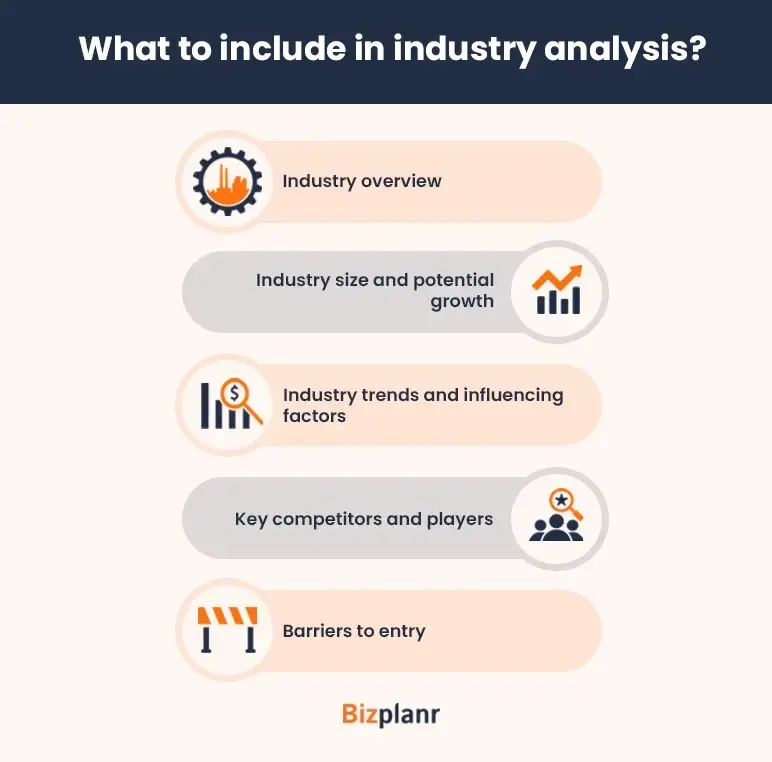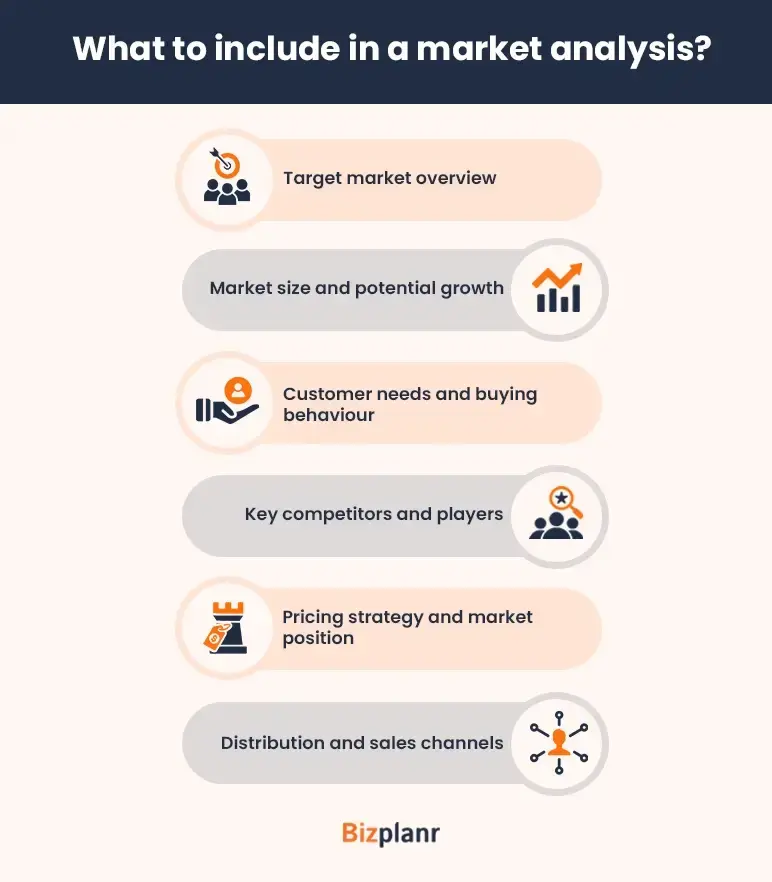I’ve seen a lot of entrepreneurs get tangled up between industry analysis and market analysis. On the surface, these terms sound similar, and many use them interchangeably. But in reality, they serve two very different purposes in your business planning.
You need to understand both when you’re trying to figure out who your customers are, where your business fits, and how big your opportunity is.
If you get this part wrong, it’s like building a house without checking the ground first.
In fact, according to a report, 35% of startups fail because there’s no market need for their product. That’s a tough lesson you can easily avoid by doing the right analysis at the right time.
Hence, in this guide, I’ll clear up the confusion for you, showing the difference between industry analysis vs market analysis. This will help you understand when to use industry analysis, when to dive into market analysis, and how both work together to shape a solid business plan.
Let’s get started.
Industry analysis vs. market analysis at a glance
Before diving into the details, let’s first briefly overview industry and market analysis. In the following table, you will find a side-by-side comparison that highlights the key differences between the two:
| Feature | Industry Analysis | Market Analysis |
|---|---|---|
| Purpose | Understand the overall health, trends, and dynamics of an industry | Understand the target customer, demand, and buying behavior |
| Focus | Big picture: trends, risks, growth rates, competitive forces | Specific segment: who's buying, what they need, and how much |
| Tools Used | PESTEL, Porter's Five Forces, Industry Reports, SWOT | Surveys, Focus Groups, Customer Interviews, Market Segmentation |
| Primary Models | Porter's Five Forces, Value Chain Analysis | TAM SAM SOM, Buyer Persona, Demand Forecasting |
| Primary Audience | Investors, Business Owners, Strategic Planners | Marketing Teams, Sales Teams, Product Managers |
| Scope | Wide industry as a whole | Narrow — specific market or customer segment |
| Time Horizon | Long-term, focusing on where the industry is headed over the years. | Short-to-medium term, often tied to launching a product or campaign. |
That’s it, industry vs market analysis concludes here. Now, let’s find out the definition, uses, and when to include these analyses in the following sections.
What is industry analysis?
Industry analysis is like getting a bird’s-eye view of the entire business world you’re stepping into. It’s where you look at the big picture that includes:
- How does the industry work?
- Who are the major players?
- What trends are shaking things up?
- Whether it’s growing or shrinking?
Analyzing these aspects helps you spot opportunities and identify potential risks before you even get started.
It’s like checking the climate before deciding to open an ice cream shop, you need to know if summer’s coming or if there’s a storm ahead.
What to include in industry analysis?
When you’re breaking down an industry, here’s what you should carefully look into.
1. Industry overview
Start by painting a picture of what the industry is.
- What does it include?
- How big is it?
- Is it growing, steady, or shrinking?
Example: “The fitness equipment industry includes manufacturers, distributors, and online sellers of gym machines and accessories, generating $15 billion annually in the U.S.”
By knowing such details, you’ll understand whether you’re entering a small niche or a massive industry with tons of moving parts. It also helps you spot if you’re stepping into a booming sector or one that’s losing steam.
2. Industry size and potential growth
Next, dig into the numbers and future prospects. Like analyze:
- What’s the current market size?
- Is it expanding or contracting?
- What’s the projected growth rate for the next 3–5 years?
This helps you find the potential of your business and provides an overview to make smarter, risk-aware decisions before investing your time and money.
3. Industry trends and influencing factors
Identify what’s driving change in the industry. With constant change in customer behaviours and a shift in demand, the industry trends relentlessly switch. Hence, during your industry analysis, check out:
- New technologies?
- Customer behavior shifts?
- Global events or economic conditions?
- New laws or regulations?
Spotting trends early gives you an edge and helps you form strategic decisions that keep your business relevant
4. Key competitors and players
You’ve got to know who’s already on the field.
- Who are the dominant companies?
- How competitive is the market?
- Are there small players making big moves?
This helps you understand if you’ll be up against industry giants or if it’s a market open to fresh players.
5. Barriers to entry
Find out what makes it tough to enter this industry. With the advancements in technology, changes in compliance, and complexity in supply chains, it’s important to identify the barriers to entry so you can prepare for challenges and avoid costly surprises.
- High startup costs?
- Regulatory approvals?
- Complex technology or supply chains?
- Fierce brand loyalty?
You need to know what hurdles you’ll face before jumping in.
What is market analysis?
Market analysis is all about understanding your customers and the environment where you’ll be selling your product or service. It digs into:
- Who are your ideal buyers?
- What are their needs?
- What are they currently buying?
- How much are they willing to pay?
It also looks at your competitors and how crowded the market is. In short, it helps you figure out whether people want what you’re offering and if there’s room for you to succeed.
What to include in a market analysis?
Industry analysis looks at the big picture of the entire industry, while market analysis zooms in on your specific market and target customers. So when you’re doing a market analysis, here’s what you need to focus on:
1. Target market overview
If you’re doing market analysis, one of the most important research you should do is on your target audience. Find out:
- Who are your ideal customers?
- Are they individuals, businesses, or a specific group?
- What’s their age, gender, income level, profession, or lifestyle?
2. Market size and potential growth
Market size and potential growth are like measuring how big the playground is and what opportunities are waiting for you there.
You need to figure out:
- How many potential customers are out there?
- How much money do they spend on similar products or services?
- Is this market growing, steady, or slowing down?
- What’s the forecast for the next few years?
This helps you judge whether there’s enough demand to sustain and grow your business.
3. Customer needs and buying behaviour
It’s important to know your customers' needs and behaviour before entering your new market, launching a product, or providing services. Thus, make sure you analyze your customer's needs and find out:
- What problems are they trying to solve?
- What products or services are they currently using?
- How do they prefer to shop — online, in-store, via apps?
- How often do they buy, and what influences their decisions?
Understanding this makes it easier to tailor your product and marketing strategy.
4. Key competitors
Another key aspect of market analysis is researching your competitors. Find out:
- Who else is serving this market?
- What are their strengths, weaknesses, prices, and market share?
- How will you differentiate yourself from them?
Doing competitive analysis is like knowing the players on the opposing team before a match.
5. Pricing strategy and market position
- What do customers currently pay for similar products or services?
- Are they price-sensitive or value-focused?
- Where will you position yourself — budget-friendly, mid-range, or premium?
Analyzing this information will help you shape your pricing and market you’re offering. Moreover, it allows you to position your business smartly in a way that appeals to your target customers and maximizes your profits without scaring customers away.
6. Distribution and sales channels
Choosing the right sales channels makes it easier for customers to find and buy from you. Hence, check out:
- Where do your customers prefer to buy from?
- Should you sell online, through retailers, direct to consumers, or via marketplaces?
This analysis allows you to meet your customers where they already like to shop, making it convenient for them and increasing your chances of making a sale.
When to use industry vs. market analysis?
As we know what to include in industry and market analysis, it’s time to know its uses. Knowing the right place, especially in the business plan, to use such analysis helps you make informed decisions.
Let’s explore:
Use industry analysis when
You turn to industry analysis when you need a clear understanding of the overall environment your business operates. Here’s when it’s especially important:
Entering a new sector
When you’re starting a business in a new industry, it’s essential to understand its structure, key players, market size, and regulations. This insight helps you make informed decisions and reduces the risk of unexpected challenges.
Evaluating threats and opportunities
A solid business plan highlights both the risks and opportunities in your industry. Industry analysis allows you to identify market shifts, new technologies, regulatory changes, and evolving customer preferences that could impact your business.
Pitching to investors, VCs, or banks
Investors and financial institutions need to see that the industry you’re entering is viable and has room for growth. Including a thorough industry analysis in your business plan demonstrates credibility and strategic awareness.
Developing the industry overview section of your business plan
Every business plan includes an industry overview to explain the current state and future outlook of your industry. Industry analysis provides the data and insights you’ll use to write this section with authority and accuracy.
Use market analysis when
While industry analysis gives you the big picture, market analysis zooms in on your potential customers and competitors. Here’s when you’ll need it:
Launching a new product or service
Before introducing a new product, you need to know if there’s a demand for it, who your ideal customers are, and what problems they’re facing. In your business plan, this insight strengthens your case by showing how your product fits market needs.
Targeting specific customer segments
Market analysis helps you break down your audience into clear, actionable segments — like age groups, income levels, buying habits, or geographic areas. This allows your business plan to clearly explain who you’re selling to and why they’ll choose you over others.
Planning, marketing, and sales strategies
A business plan isn’t complete without a smart marketing and sales strategy. Market analysis reveals where your customers shop, how they prefer to buy, what influences their decisions, and how price-sensitive they are. This information helps you shape marketing campaigns and sales channels that truly connect.
Building the market research section of your business plan
Every strong business plan features a market research section. Market analysis provides the data and insights needed to explain market size, customer preferences, competitors, pricing trends, and how your business will capture its share.
The bottom line
The big takeaway in market analysis vs industry analysis is simple: Industry analysis helps you understand the big picture, how the entire industry works, moves, and where it’s heading. Market analysis, on the other hand, zooms in on your specific target customers, their needs, preferences, and buying habits.
Now, whether you’re just starting, thinking of launching a new product, or already running a business, I’d strongly recommend doing both, especially when you’re preparing your business plan. Like the old saying goes:
"The more you know, the better you grow."
That said, I’ll be honest with you—industry and market analysis take time, effort, and can get a little overwhelming. That’s where smart tools come in handy. AI-powered platforms like Bizplanr can help you handle these tasks faster and more efficiently, especially while preparing business plans. It’s like having a shortcut without cutting corners.
Need help with industry or market analysis? Try Bizplanr today!
Get Your Business Plan Ready In Minutes
Answer a few questions, and AI will generate a detailed business plan.
Frequently Asked Questions
Can I skip industry or market analysis in my business plan?
No, you really shouldn’t. Both industry and market analysis are essential parts of a good business plan. They show investors, banks, and partners that you understand the world your business will operate in and who you’re selling to. Skipping them leaves your plan incomplete and makes your business look risky and poorly researched.
Which one should I do first?
Start with industry analysis. Because it gives you the big picture, helping you understand overall trends, risks, and opportunities. Once you’ve got that, dive into market analysis to zoom in on your target customers and competitors.
Do these analyses help in securing funding?
Yes, when investors, banks, or grant committees read your business plan, they want to see proof that you’ve done your homework. Industry and market analysis show them you’re not guessing—you’ve researched, planned, and know exactly where your business fits. It gives them confidence that their money will be in capable hands.







